6 Resistance, Resilience, and Remembering: Juárenses Surviving Feminicide and the ‘Great Violence’ in Ciudad Juárez
Cynthia Bejarano
Cynthia Bejarano, Ph.D.
Introduction: The ‘Great Violence’ and a Community’s Determination to Resist
During moments of grave adversity, communities demonstrate their resilience by engaging in acts of civil disobedience to protect themselves. Extraordinary displays of resistance and courage take place in Juárez every day[1]. Since the 2008 conference, “Missing Women: Decolonization, Third Wave Feminism, and Indigenous People of Canada and Mexico,” at the First Nations University of Canada and the University of Regina, violence has overwhelmed Juárez and forever changed it. Fear, death, and devastation characterized the city and surrounding region from 2006 to roughly 2012, in what journalist Kent Patterson has simply called the ‘Great Violence.’ Although the feminicides[2] that made Juárez infamous continued across the state of Chihuahua, they were overshadowed by this greater violence, as headlines of macabre killings linked to cartel violence made international headlines. The fighting was principally fueled by drug violence as feuding Mexican rivals—the Juárez and Sinaloa cartels—fought for control of the plazas, the lucrative clandestine corridors used to transport drugs across the U.S. border.
Then Mexican President Felipe Calderón launched a war on drugs that mirrored the failing war on drugs that the U.S. has fought and defended for over forty years. The U.S. enthusiastically supported Calderón’s drug war in Mexico but failed to take a critical stance, outside of progressive circles, on the colossal U.S. consumer drug market that contributes to an estimated $426 to $652 billion worldwide drug industry (Tharook 2017). The appetite for drugs in the U.S. has driven much of the bloodshed that came to broadly depict life in Juárez and across regions of Mexico. It directly led to the now more than 100,000 deaths and over 30,000 disappearances that have resulted from the Mexican war on drugs and its lingering aftermath (www.mileno.com). Many experts argue that the carnage has not dissipated since 2006 and that the above numbers should be doubled to accurately depict the total number of deaths. Since 2006, violence ensued at a feverish pace and government officials responded with an unbridled military and policing force that only exacerbated human rights atrocities, assaults, disappearances, kidnappings, and deaths. Chihuahua state authorities, along with the Mexican military, were accused of large-scale systemic corruption, impunity, and human rights violations. For example, between 2007 and 2009, in an operation called Operativo Conjunto Chihuahua, President Calderón deployed 5,000 troops to fight drug cartels and street violence, such as kidnappings, car jackings, extortion schemes, robberies, and drug cartel murders (Bejarano and Morales 2011).
During the ‘Great Violence,’ people were equally fearful of cartels and corrupt law enforcement at both the federal and state level, and they remained terrified of the rising tide of street level crimes. The uptick in everyday violence that impacted ordinary citizens included narco deaths[3], and the subsequent impunity for criminals whose crimes went unresolved or were not investigated. The Mexican criminal justice system was overwhelmed. Any references to feminicides were ancillary to the anxieties and violence of the everyday. From 2006 to 2012, murder victims were popularly portrayed as active participants in the drug trade. Murdered women were unfairly characterized as drug mules, extortionists, or drug traffickers. Debates as to which murders constituted feminicides erupted with arguments as to the accuracy of the number of deaths, the reason for the deaths, and whose deaths were over- or undervalued. Men’s deaths also suffered from the same judgement; the death toll for men was ten times that of women.
Investigations into feminicides nearly halted when the Mexican criminal justice system, especially its medical examiner’s offices and criminal investigations unit, was saturated with assassination investigations. Bodies arrived at the morgue faster than personnel could work to preserve and/or work to identify corpses or remains. Over this period, approximately 13,000 people were killed in Juárez; 2010 marked the deadliest year with 3,075 murders (Villagran, 2014 as cited in Prieto, Morales, and Bejarano 2014). This number does not include statewide deaths, disappearances or bodily harm suffered across the state of Chihuahua due to Calderón’s drug war. Ordinary people fell victim to extortion, random and targeted kidnappings, and street-level violence.
This violence dramatically altered socio-cultural practices across the city. Juárenses curtailed their evening activities and outings, retreating to their homes before dark and relegating social activities to house parties or other intimate gatherings. Warnings to go home before dark were no longer restricted to young women for fear of feminicide; this message was relayed to all citizens. I remember friends sharing that house parties would at times turn into sleepovers, so that people would not have to return home late at night. Some gatherings were restricted to only small circles of friends or family. When driving, people were on their guard at stop signs and stop lights. Many carried only the minimum amount of cash needed. Others carried only one or no forms of identification for fear of being robbed or later extorted. Some women journalists I know carried a purse with nominal cash and lay it on the passenger seat of their cars. If accosted, they could hand their assailant that purse, while hiding their identification and other items elsewhere in their vehicles or on their bodies. People learned to maneuver themselves strategically. Physical and psychological fears remained stark features of daily life acutely embedded in one’s psyche.
I continued to travel to Juárez and Chihuahua during all but two years (2010 to 2012) of this ‘Great Violence.’[4] In 2008, I remember the arrival of an unparalleled military presence. I was in Chihuahua City during my sabbatical volunteering with the Centro de Derechos Humanos de las Mujeres (Center for Women’s Human Rights). Witnessing soldiers atop military vehicles driving down the streets of Chihuahua City was terrifying; people across the city felt a profound change in how everyday life functioned. Soldiers also inundated Juárez, and the number of military checkpoints grew. Bogus checkpoints staged by cartels and other criminal entities appeared throughout Juárez and across Chihuahua. When approaching a checkpoint across the state of Chihuahua, one did not know who they would encounter: military, law enforcement, or narcos. At times, it seemed as if all three were in collusion with each other.
Gunshots were common in some segments of Juárez. For instance, in one account of violence retold to me by a sister of a feminicide victim, she once heard gunshots as someone was executed across the street while she sat in traffic. Her children asked if they were fireworks, and she said ‘yes.’ As they drove down the road, she told them to duck in the backseat because the fireworks were so powerful that they might get hurt; it was midday. Stories like this were common. The same family once called on me to contribute to a monetary collection; an extended family member had been kidnapped in a secuestro express, a common practice at the time, where criminals would kidnap an arbitrary person for ransom. The family desperately worked with the police kidnapping unit to negotiate with kidnappers for their loved one’s safe return. People paid what they could, as kidnapping units instantly sprouted from local police departments because of the proliferation of kidnappings. Virtually anyone could be a target; people with businesses were usually at greater risk. At the time, secuestros express and other forms of extortion and violence were in part due to the greater decay of the city associated with cartel wars and economic recession (Morales, Prieto, Bejarano 2014).
The Exodus from Juárez and the Paso del Norte Region’s Transformation
Over this challenging period, victimization was boundless. The affluent and poor of Juárez received menacing phone calls from mysterious callers demanding a cuota, an extortion fee to protect their businesses or homes. If people did not pay the cuota, they were beaten, kidnapped, or even killed. According to Juárez sociologist Alberto Ochoa-Zezatti, roughly 450,000 people fled Juárez from 2007 to 2011 (Cave 2013 as cited in Prieto, Morales, and Bejarano 2014). By 2008, between 30,000 and 125,000 Juárenses had relocated across the international border to El Paso, Texas, and over 10,000 businesses closed from 2007 to 2011 (Martinez et al. 2011; O’Rourke and Byrd 2011 as cited in Morales, Prieto, and Bejarano 2014). The number of people that returned to Juárez is unknown. At one point, the Juárez mayor had also relocated to El Paso for his safety and crossed into Juárez daily for work. He received sharp criticism by Juárenses who remained in Juárez (Sanchez 2009).
The binational region was transformed with the affluent moving to El Paso and the surrounding area and re-establishing businesses from Juárez like popular restaurants that El Pasoans would frequent when visiting Mexico (Prieto, Morales, and Bejarano 2014). One symbolic development was a mercado, an open-air market akin to the famous mercados of Juárez. It was built in the downtown El Paso district, the Segundo Barrio, only a few city-blocks from one of the international bridges linking the two cities. These popular simulacra of Juárez in El Paso continued for some years. They seemed to indicate to El Pasoans and tourists that it was no longer necessary to cross into Mexico to enjoy the culture and cuisine of Juárez. The simulacra were widespread.
As a border person who has crossed into Juárez throughout my life, I was saddened and dismayed at these changes. At the same time, I sympathized with the Mexican diaspora relocating across the international boundary, often asking myself if I would do the same to safeguard my family. The reverberating message in the region was that safety in Juárez was dubious, and despite efforts to live routine lives, El Pasoans and others curtailed visits to Juárez or visited with trepidation. Some applied the tactics that frequent border crossers used of walking across the international bridge to Juárez rather than driving, or visitors only carried identification with the absolute minimum amount of cash. For people engaged in writing about human rights and social justice as journalists, or who were directly working against narco violence, gender-based violence, and state violence, or the culmination of all three, fleeing Mexico was their only option.
The Activist Diaspora, Political Asylum and Chronic Threats
Some people sought political asylum across the border in the U.S. while seeking refuge with relatives or other potential sponsors[5]. Those with no U.S. contacts were forced into the infamous immigrant detention center in El Paso, popularly known as El Corralon (large yard) to await their asylum hearings. Some activist women and their families, such as Cipriana Jurado and Marisela Ortiz, who were involved in the anti-feminicidio movement and in fighting cartel and military violence, were forced to flee the city.
Cipriana, a well-known labor rights activist turned anti-feminicide activist in the 1990s, fled Juárez in June 2010. Prior to her leaving Juárez, she was apprehended by plainclothesmen claiming to be federal police officers in 2008. She was placed in police custody but was ultimately released the following day after immense local pressure by a well-known Mexican congressman and local activists (Rivas 2011). Cipriana continued to confront tremendous scrutiny and received threats to her life, which led her to make the painful decision of fleeing Mexico during this time and to seek political asylum in the U.S.
Another prominent activist, Marisela Ortiz, a journalist and schoolteacher turned anti-feminicide activist, fled Juárez because she feared for her life after her daughter’s fiancée (and later her brother) were killed in Juárez (Rivas 2011). Marisela began her activist work when her 17-year-old student, Lilia Alejandra Garcia Andrade, was killed on February 14, 2001. Marisela, Norma Andrade (Lilia Alejandra’s mother) and Maria Luisa Andrade (Lilia Alejandra’s sister) co-founded the well-known Juárez non-profit Nuestras Hijas de Regreso a Casa (May our Daughters Return Home). All three women fled Juárez after their lives were threatened.
Others, like Mexican journalists and even Mexican law enforcement, sought asylum in the U.S. Journalists have systemically been targeted for their coverage of narco violence, state corruption and impunity, and the feminicides. Journalists with Reporters without Borders claim that Mexico ranked the deadliest country for the news media in the western hemisphere (Borunda 2017). It is safe to say that threats to journalists come from numerous places, and the threat of violence to journalists is ubiquitous. In March 2017, Miroslava Breach Velducea, a Chihuahua City based journalist and editor of the El Norte newspaper in Juárez and a correspondent for the national Mexican newspaper, La Jornada, was gunned down in the driveway of her home as she was taking her son to school. Some accounts of Miroslava’s death claimed that she was reporting on cartel activity in Chihuahua City and was killed because of this. Overwhelmingly, and despite unrelenting violence, most people remained in Juárez, as all of Mexico was ravaged by the drug war.
Fear continued to dominate people’s lives. A life-long activist and key organizer in the anti-feminicide movement in Chihuahua City told me that, “he would leave his house not knowing if he would return home that evening.” He and others made statements like this often. I still cringe when thinking of it. This sentiment was also echoed by activists and ordinary citizens. Local authorities and law enforcement could not, with any great success, protect the citizens of Chihuahua. Justice systems were, and still are, beleaguered with criminal cases or are void of any real ability or resolve to fight crime. Justice remains arbitrary with approximately 93.7 percent of criminal cases in 2015 going unsolved throughout Mexico. The Mexican National Institute of Geographic Statistics has referred to this number as “the black statistic,” since few criminal cases are solved; they noted a slight increase in resolved cases in 2015 by less than one percentage point from 92.8 percent in 2014 (INEGI 2016). Citizens justifiably have lost faith in their justice system.
Responding to the ‘Great Violence,’ an Insistence to Resist
Throughout the ‘Great Violence,’ people did not call the police for assistance; instead, they relied on each other for protection as a form of community security. When taken to an extreme, however, this mutual protection was akin to vigilante justice. One unforgettable story is of a small Chihuahua agricultural community named Ascension that took justice into their own hands in 2010. Locals did not typically call police due to their mistrust of authorities, so the people from Ascension took guards’ shifts around their small town.
During a botched kidnapping attempt by local young men operating as a self-made kidnapping unit, violence unfolded. The adolescents attempted to abduct a seventeen-year-old girl from a restaurant where she worked, but they failed when community members chased their get-away vehicles. Police and military personnel and family and friends were called by the girl’s father to search for her. The girl was rescued and several of the kidnappers were arrested by local police; two were apprehended by community members.
Some of the kidnappers were transferred to Juárez, but two of the youth were beaten by community members. Fearful that police would take the kidnappers to Juárez and release them without a trial, people blocked the police and paramedics from reaching the two young assailants. They eventually suffocated inside the police car where temperatures reached 100 degrees with the windows rolled up. Ironically, the police had kept the windows rolled up for the kidnappers’ own safety (Sierra 2010). Although this is an extreme case, for local authorities and the international community, it reinforced that legitimate government involvement was needed to curtail the violence. It also illustrated how people were willing to take matters into their own hands if the police were unwilling to. People were exhausted and outraged from the continuing violence. Their efforts to protect their beloved city and families weighed heavily on everyone.
The family and friends of Juárenses on the northern side of the international line were also perpetually warned about the violence. A local El Paso, Texas news station covering the Paso Del Norte region (Chihuahua, Mexico; Texas; and New Mexico), initiated a daily segment exclusively on the death toll and violence in Juárez. Juárez was represented as a danger zone, with discussions of sending the U.S. National Guard to ‘protect’ the U.S. side of the border in case violence spilled into the States (Estrada, Keck, Rodriguez, and Starr 2009). The issue of spillover violence was perpetually exaggerated in this region, but it gained momentum along major drug routes into the U.S., especially in border regions like Juárez-El Paso and in south Texas/south eastern Mexico’s Laredo-Nuevo Laredo border region. This era personified social fears, scapegoating, and the criminalization of an entire nation, despite the rationale for so much of the violence pointing to U.S. drug demand and consumption.
Families were destroyed, businesses and homes were abandoned, and the traumatic series of deadly events over so many years seemed to continue without end. Still, life went on for Juárenses and people across the state of Chihuahua determined to live ordinary lives, despite the adjustments to regular street routes and routines, and the curtailment of daily schedules. Embedded in this history was a dogged refusal to accept this conflict and carnage. This refusal to succumb to violence is the most significant of narratives.
Reminiscent of the cries for justice that mothers of feminicide victims have demanded for over twenty years, people organized against this large-scale violence. Youth, civic-society, and anti-feminicide groups were at the helm of activist work. Sizeable protests took place early in the ‘Great Violence’ period where thousands of people marched on the streets of Juárez demanding a stop to the random and targeted cartel and street violence. During one protest, Juárez youth lay symbolically on a street in the protest’s path as if they had been assassinated. One impromptu protest took place in May 2009, after the random death of Manual Arroyo Galván, a professor at the Universidad Autónoma de Ciudad Júarez. He was shot several times en route to El Paso, Texas, when he refused to surrender his car during a carjacking. His students and others took to the streets, drawing inspiration from the Argentine-based artist, Fernando Traverso, who used a bicycle to “represent the disappeared and missing from Argentina’s Dirty War” (Driver 2015, 41). The region exploded in anger as people fiercely mobilized in response to these acts of violence, determined to take their communities back.
People throughout the U.S. borderlands were similarly outraged since the violence had reverberating effects across the region. Families and friends in the U.S. also lost loved ones to the violence. People in El Paso and southern New Mexico held several protests in solidarity with activists in Juárez. During a protest in 2009 in a desolate, sandy spot in Sunland Park, New Mexico, across from Juárez, people on both sides of the border joined to protest the bloodshed (Figure 1). In this picture, children from Lomas de Poleo, a neighborhood on the edge of Juárez abutting the international border fence, play volleyball with U.S. protestors[6]. While Paula Flores[7] and I visited with each other through the international fence, the U.S. border patrol watched from nearby, as armed Mexican federales on the opposite side of the fence watched the protest unfold (Figure 2).

Figure 1: Paula Flores and I talking through the U.S.–Mexico border fence during an Anti-Violence Protest in 2009. Photo courtesy of Jeff Shepherd.
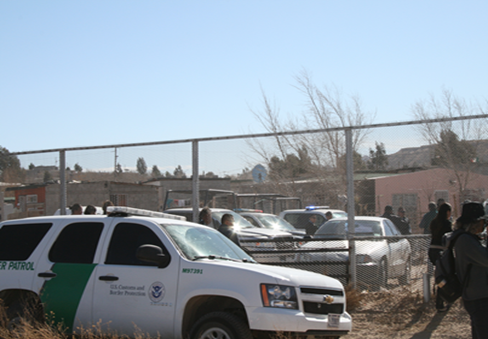
Figure 2: U.S. Border Patrol watching protestors as Mexican federales surveilled Mexican protestors at the international fence. Photo courtesy of author.
I remember feeling inept and anxious at the thought of Paula, or the other activists I admire and love being arrested, because the border fence barred those of us on the U.S. side from being able to do anything. I imagine Paula and others would have felt the same if the U.S. border patrol would have sprung on us as well. Authorities on both sides warily looked at the peaceful assembly of people as they sat in their SUVs or trucks. Some of them stood near their vehicles closely watching the crowd, more annoyed at the assembly then concerned over children playing volleyball across the fence, or activists demanding action from the uniformed men that represented Mexican and U.S. nation-states.
Mothers of the missing and murdered, anti-feminicide activists, clergy, journalists, and other community members congregated on both sides of the border chanting anti-violence slogans with hopes that our collective voices would be heard. Lucha Castro and Gabino Gomez (Figure 3), two anti-feminicide activists from Chihuahua City and co-founders with others of the Centro de Derechos Humanos de las Mujeres (CEDEHM) (Center for Women’s Human Rights), and Justicia Para Nuestras Hijas (Justice for Our Daughters), stood on the Mexican side of the international fence during this same protest. We visited and talked, touching hands through the fence. Handshakes through the fence had to replace the warm embraces of solidarity that typically accompanied visits. As a member of the Chihuahua based Mujeres de Negro (Women in Black), Lucha was wearing the group’s ubiquitous pink hat that stated, “Ni Una Mas” (Not one More). Both were looking through the international fence with banners and images denouncing the violence.
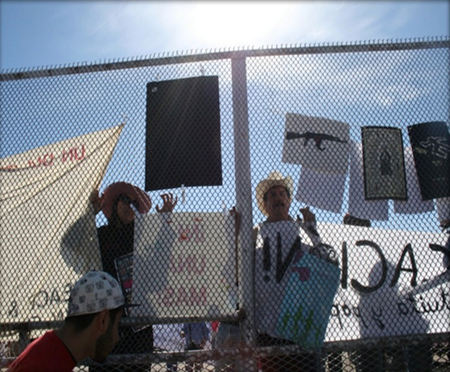
Figure 3. Lucha Castro and Gabino Gomez looking at U.S. protestors during the Anti-Violence Protest in 2009. Photo courtesy of author.
Lucha and Gabino launched leaflets over the fence to me to distribute to protestors on the U.S. side of the border (Figure 4). The leaflets included information on Justicia Para Nuestras Hijas and statistical information on the violence in Chihuahua. I caught the leaflets as they fell from the sky, like protest messages from heaven. I waited for the U.S. border patrol to confiscate them, but they did not.

Figure 4 Gabino Gomez in Juárez leaning on a ladder propped against the international fence dropping leaflets at me to distribute on the U.S. side. Photo courtesy of author.
Although the visual representations and rallying cries of the many protests were uniquely different, they suggested that the anti-feminicide movement was a constant tide against turbulent political, economic, and social unrest. At the border protest, one activist mother, Olga Esparza, mother of Mónica Janet Alanís Esparza, an eighteen-year-old university student attending the Universidad Autónoma de Juárez, who went missing in 2009, spoke to journalists. Standing on a platform on the Juárez side of the border, Olga spoke into a microphone about her missing daughter and desperately relayed her daughter’s story of disappearance, while hoping to still find her alive.
Since approximately 1993, several women and girls’ bodies have been found. In some instances, three to eight victims were found in the same location (Candia et. al. 1999; Washington Valdez 2006; Fregoso and Bejarano 2010; Staudt and Mendez 2015; Lozano 2019). Some of the geographic locations were near or in the vast desert area close to Juárez: the Lote Bravo, the Cerro del Cristo Negro, the Loma Blanca, the Campo Algodonero, and the Arroyo Navajo in 2012[8]. According to Lozano, in June 2016, eight women’s bodies were found over one week in a river canal near the El Paso/Juárez border (2019). One of the most well-documented cases of feminicide was the finding of eight young women (some only girls) in the Campo Algodonero in 2001, which later helped set legal precedent on the murders of women and girls in Mexico through the inter-American court system.
The Campo Algodonero as Legal Framework for Future Feminicide Cases
The discovery of the women’s bodies on November 5 and 6, 2001 became an iconic story. Irma Monreal, Josefina González, and Benita Monárrez were the lead petitioners in the case of González et al. (“Campo Algodonero”) v. México, which was decided by the Inter-American Court of Human Rights (IACHR) on December 10, 2009. The case was admitted to the IACHR in 2007 and tried in Santiago, Chile (Bejarano 2013). The Court’s ruling condemned the Mexican state for human rights violations and ordered various forms of reparation and redress, which have not entirely been fulfilled. Even so, the case was a landmark decision, providing “legal precedent for cases of gender violence in a non-war context and for enumerating feminicide in international law” (Fregoso and Bejarano 2010, 6). It also “establish[ed] a solid framework for legal interpretation with a gender perspective from which further development of the legal doctrine can take place” (Red Mesa and CLADEM 2010, 53 as cited in Bejarano 2013, 2). The case signified critical advances in exposing the impunity, corruption, and apathy that was rampant in criminal investigations. Moreover, it was a historic victory for the victims’ families and their advocates.
The Court’s ruling mandated that the Mexican government make a public apology; hold a memorial service for the women and girls; create a public monument to the girls and young women killed at the Campo Algodonero; establish an electronic database of all missing women; and implement a DNA database; among other demands (Bejarano 2013). It took two years for the state to give the apology, and on November 7, 2011, the Mexican government inaugurated the monument to Laura Berenice (Benita Monárrez’s daughter), Claudia Ivette (Josefina Gonzalez’s daughter), and Brenda Esmeralda (Irma Monreal’s daughter) at the cotton field site, just blocks away from the U.S. Consulate in Mexico.
Today, the area is enclosed by a pink metal fence and a large pink wall that hides it from a busy street intersection and renders it indiscernible from the car traffic. It is also inaccessible to visitors in vehicles, since there are only two or three parking spaces available to park in front of the monument. The transformed campo algodonero which was a popular site of resistance, is rendered ‘visitless’ through its inhospitable design and obtuse vehicle and foot traffic. One could easily argue that the design is intentional. Inside the pink gates, a marbled tile half-circle wall serves as the monument, with a large pink cross at the center. The monument is criticized for its sterilized appearance. It is no longer the sacred space that came to represent the site for incalculable protests and memorials remembering all the feminicide victims.
The discoveries of mass graves did not cease with the Campo Algodonero case, however. Three teenage girls were discovered at the Cerro del Cristo Negro on the outskirts of Juárez near Rancho De Anapra. They were found by girls playing nearby on February 17, 2003. The victims were all girls themselves: Esmeralda Juárez Alarcon (sixteen years old), Juanita Sandoval Reina (seventeen years old), and Violeta Mabel Alvidrez Barrios (eighteen years old). This incomprehensible loss of life remains painful to remember and recount, even though I never knew these families or their young daughters. The citizens of Juárez and the tireless efforts of advocates and families of feminicide victims persist in their vigilance, even moreso that girls, women, and now boys and men continue to disappear as the Arroyo Navajo case exemplifies.
The Arroyo Navajo Case, the Consequence of Unchecked Violence
In 2012, another gruesome discovery was made by passersby who stumbled onto a large group of human remains in the Valle de Juárez in a dry riverbed called the Arroyo Navajo. The remains were tested by several units including the Crime and Forensic Science labs in Juárez, the U.S.–based BODE lab, and the world-renowned Equipo Argentino de Antropología Forense (EAAF) for DNA evidence. Of the remains tested, seventeen girls who had gone missing between 2008 and 2010 were identified; they ranged in age from fifteen to twenty-two. It is unclear how many other missing have been identified—biologically male or female.
Several rastreos[9] have taken place in the Valle de Juárez’s Arroyo Navajo. Several rastreos found more remains, more victims’ clothing, or other pertinent items that offered insight into what happened to the missing. It is still unclear how many remains have been discovered and how many victims identified. The desert’s vastness makes it impossible to know how many bodies are hidden there and how many bodies were swallowed by its infinite sands. One report indicates that fifty-three remains have been found and twenty-three have been identified, although it is uncertain whether all twenty-three victims were women and girls (Figure 1). Some of those victims included girls missing since 2008[10]. These girls were forced into prostitution and eventually killed (Carmona 2017).
| Identified Woman/Girl | Age | Date Missing |
|---|---|---|
| Brenda Berenice Castillo García | seventeen | January 6, 2009 |
| María Guadalupe Pérez Montes | seventeen | January 31, 2009 |
| Marisela Ávila Hernández | twenty-two | March 18, 2009 |
| Mónica Alanís Esparza | eighteen | March 26, 2009 |
| Lizbeth Aviles García | seventeen | April 22, 2009 |
| Perla Ivonne Aguirre González | fifteen | October 11, 2009 |
| Idalí Juache Laguna | nineteen | February 24, 2010 |
| Yasmin Taylen Celis Murillo | seventeen | April 4, 2010 |
| Beatriz Alejandra Hernández Trejo | twenty | April 27, 2010 |
| Jessica Leticia Peña García | fifteen | June 16, 2010 |
| Yanira Frayre Jaquez | fifteen | June 16, 2010 |
| Deysi Ramírez Muñoz | sixteen | July 28, 2010 |
| Andrea Guerrero Venzor | fifteen | August 19, 2010 |
| Jessica Terrazas Ortega eighteen | eighteen | December 20, 2010 |
| Monica Liliana Delgado Castillo | eighteen | October 18, 2010 |
| Jazmin Salazar Ponce | seventeen | December 27, 2010 |
Figure 5. Women and girls found in the 2012 Arroyo Navajo case.
On July 2015, five men were convicted of murder, drug trafficking, and forced prostitution and were sentenced to 697 years and six months each in prison for the murder of the girls and young women whose names appear above (Frontera Norte Sur 2015). Authorities used this case as putative proof that they were taking feminicides seriously, even though the men would never live long enough to fulfill their almost seven-hundred-year sentences.
I keep thinking about the image of Olga Esparza at the 2009 cross-border protest imploring people to search for her daughter. It was reminiscent of the numerous times I had witnessed other activist mothers plead with authorities, journalists, foreigners, locals, or anyone willing to listen to them to help “bring their daughters back home.” The horrifying discovery at the Arroyo Navajo, like every feminicide, defies reality. The resilience and hope that activists inspire is what reminds us of our humanity and the need for solidarity across borders.
The Teachings and Resiliency of the Anti-Feminicide Movement
The visibility of anti-feminicide activists vigorously participating in and at times, leading protests, or serving as plaintiffs in legal cases, or leading rastreos, demonstrates how significant a role the anti-feminicide movement has played for over twenty years in addressing widespread violence. Their coalition-building demonstrates the strength, continuity, and vitality of the movement that began in 1993, and continued during the ‘Great Violence’ and even beyond. I heard activists, journalists, and family members repeatedly state that if authorities had investigated and put a stop to the feminicides, perhaps the large-scale violence would not have erupted as it did. It is hard to predict whether the death toll would have taken a turn for the better, or if authorities would have or even could have stopped such bloodshed from occurring. Despite it all, efforts to combat the violence continued by civic society and others.
One prominent yet controversial campaign that was launched by government officials, along with some well-known members of Juárense civic society, was called Todos Somos Juárez (We are all Juárez). The campaign aptly promoted the logo “Amor por Juárez” (Love for Juárez), which grew in popularity and was visibly displayed on bumper stickers and t-shirts across the borderlands (Mesa de Seguridad y Justicia 2017). This initiative reminded me of phrases that I had heard in the anti-feminicide movement, like “todas son nuestras hijas” (they are all our daughters) referencing the feminicide victims of Juárez and Chihuahua City. Images dedicated to protesting feminicides had a dual meaning and exemplified the large volume of overall deaths in the city.
Since 2002, an image of a massive cross made of railroad ties sits in one of the most visible and traveled crossing points from El Paso, Texas into Juárez. This iconic image has represented Chihuahua’s feminicides for over fifteen years and was permanently cemented into place by activist mothers, activist groups, and their supporters. At one point, metal nails hammered into the wooden cross held the names of feminicide victims written on white strips of paper tied with ribbon.
During the sweeping violence from 2006 to 2012, the monument not only came to represent feminicides in Chihuahua but also the demise of so many others, as Figures 6 and 7 depict. At some point during the ‘Great Violence,’ a massive black cloth with the word, Justicia written above a blood-stained Mexican flag was draped over the feminicide cross, assumedly by activists. Above the flag, one can still read the popular slogan “Ni Una Mas” that came to personify the feminicides across Chihuahua.
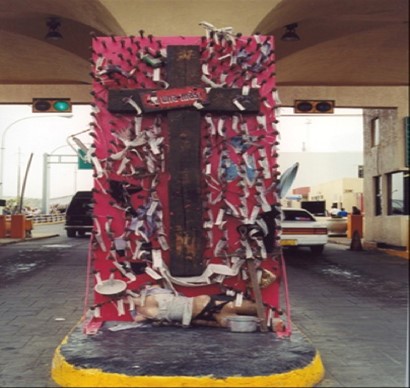
Figure 6. The cross representing feminicide victims at the Juárez Santa Fe Bridge Crossing, circa 2003. (Photo courtesy of author.)
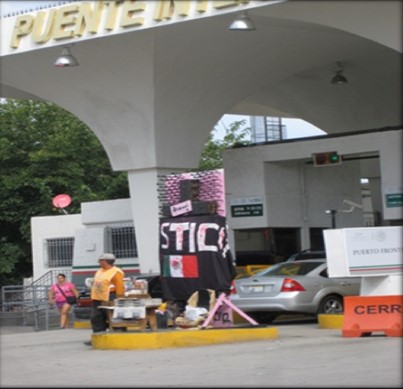
Figure 7. The same cross representing feminicide victims, but with a blood-stained Mexican flag, 2009. (Photo courtesy of author.)
Much of the imagery and phrases of the anti-feminicide movement, I would argue, significantly inspired the larger anti-violence manifestations that gained traction for so long in Chihuahua. For more than twenty years, the anti-feminicide movement and its waves of activism have remained the clarion call for justice by demanding a response from those in positions of power. Staudt and Mendez (2015) have referred to the mothers of the feminicide victims as “game changers,” crediting them for inspiring the struggle against narco violence, disappearances, and the widespread bloodshed that took hold of Mexico.
Mendez and Staudt (2015) describe the first wave of the anti-feminicide movement as stemming from the early 1990s to the early 2000s when a large-scale national and international presence by families of feminicide victims, activist groups, civic-society, academics, legal scholars, and international allies was collectively built. The second wave of the anti-feminicide movement remained less visible than the first, but was part of international coalition-building from 2010 to 2012. Finally, the third wave of the anti-feminicide movement witnessed a lull due to large-scale narco violence, and the threats against activists that resulted in the deaths of prominent figures in the anti-feminicide and anti-militarization movement. All the while, Juárez and Chihuahua City groups remained vigilant in the anti-feminicide movement, protesting the deaths of so many and risking their lives in the process. This third wave, as described by Staudt and Mendez (2015), was coupled with anti-militarization grassroots and civic-society alliances that raised awareness of the role that militarizing Chihuahua and subsequent Mexican states had on the uptick in violence against all citizens. Hector Delgado Padilla poignantly called the militarization advent, the “maquinaria del miedo” (machinery of fear) where “la fuerza habla” (force talks) (2009, 309 as cited in Staudt and Mendez 2015).
Nina Lozano (2019) adds a fourth wave to the anti-femicide movement. Like Staudt and Mendez, Lozano also discusses in her work, “waves of feminicidio” that include four waves. Her discussion is similar to what Staudt and Mendez argue about the over twenty-year movement. However, Lozano expands her analysis to include a fourth wave that covers the years 2015 to the present. Lozano calls this fourth wave, the “Movement and Feminicidio Resurgences” and chronicles a new era of young activists who collectively call themselves, “the daughters of feminicidio” (2019). Similar to Staudt and Mendez (2015), Lozano (2019) points to social media and the larger growth of activist men and fathers, like José Luis Castillo, whose fourteen year-old daughter Esmeralda was killed, as new indicators in the perpetually moving and dynamic evolution of the anti-feminicide movement.
Despite the ongoing fear and violence that continues to plague Mexico, the resilience of people remains intact. The lasting presence in Juárez and Chihuahua of groups like Justicia Para Nuestras Hijas, the CEDEHM, the Mesa de Mujeres and the Centro para el Desarollo Integral de la Mujer (CEDIMAC), continue to play significant roles in the anti-feminicide movement by remaining the proverbial ‘pebble in the shoe’ of the Mexican government—always vigilant, visible, and loud. Community observatories on feminicide[11] and the issue of the ‘greater violence’ were established (Fregoso and Bejarano 2010; Staudt and Mendez 2015), and groups’ uses of social technology like Facebook, Twitter and listservs to maintain solidarity ties with international efforts were prominent (Staudt and Mendez 2015). Young people and on the ground activists like, Rosas de Juárez (Roses of Juárez), Frenté Marginal (Marginal Front), Pink Nopál (Pink Cactus), and the Grupo de Acción por los Derechos Hermanos y la Justicia Social (Action Group for Human Rights and Social Justice) (Lozano 2019), use new strategies in the growing anti-militarization/anti-violence movements in protest of the disappearances, killings, and overall calamity occurring.
Countless protests marked these years of struggle. Of those that I attended, one was an anti-feminicide march that took place with mothers from Chihuahua City and Juárez, and activists from the Centro de Derechos Humanos de las Mujeres (CEDEHM) called La Campana de Justicia (the Bell of Justice). Families marched or caravanned from Juárez to Mexico City and back, ringing a large bell made of melted donated keys that symbolized the calls for justice by families of the disappeared or feminicide victims. The massive bell sat on the back of Gabino Gomez’s truck, a member of the CEDEHM, as it made its trek from Juárez to Mexico City and back again. La Campana de Justicia stopped in cities, small and large, along the way to Juárez, where activists and families of the murdered gathered together behind the downtown Catedral across the street from the Centro Municipal de las Artes. The activist mothers at the event would ring the bell and say a few words, often denouncing the government’s unreliable investigations into their daughter’s cases.
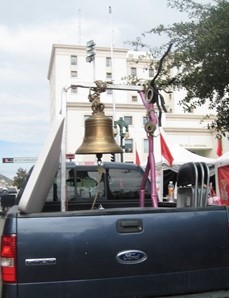
Figure 8: The Bell of Justice campaign demanding an end to feminicide in 2009 outside the Governor’s Palace in Chihuahua City, the main government offices for the State. Photo courtesy of author.
Just weeks after the Bell for Justice protest, I traveled to Albuquerque, New Mexico with Paula Flores (Sagrario Gonzalez’s mother) and Irma Monreal (Esmeralda Hererra’s mother)[12] at the request of U.S. mothers whose daughters were found in 2011 in the west mesa of Albuquerque. The finding of eleven bodies on the west mesa of Albuquerque’s high desert was eerily like the grisly discovery at the Campo Algodonero in 2001. Like Juárez, these women’s remains were found by passersby walking their dog in a newly cleared, empty lot primed for suburban development.
I visited the location of the west mesa murders in 2012. I had flashbacks of walking irrigation canals and a dry cotton field at the Campo Algodonero in Juárez during a rastreo I was involved with in 2002. A few short years after the Campo Algodonero rastreo in 2002, I went to Chihuahua City with Eva Arce, mother of Sylvia Arce who disappeared in 1998 to meet with the human rights attorney, Adriana Carmona and motherist activist, Norma Ledezma. Norma took us to the site where her daughter’s body, Paloma was found in 2002. In Chihuahua City, we walked an arroyo that like the west mesa was at the time being prepared for a neighborhood development in 2005. We walked in the Chihuahua City arroyo, on the edge of the city, still searching for any clue of what happened to Paloma. Each time I searched empty lots or fields where girls’ bodies were discarded, I realized that I was not only chasing mothers’ memories, but I was also chasing my own ghost memories of walking from desert to desert looking for traces of who these girls were, wishing I could recall a memory of knowing them when they were alive, rather than recognizing them from a picture or memory book.
During a 2009 Albuquerque trip with Paula and Irma, Paula was interested in taking la Campana de Justicia across the international border to New Mexico, but we were unable to. Instead, I traveled with Paula and Irma to meet with one New Mexico mother whose sixteen-year-old daughter was found on the west mesa. The three women consoled each other as they shared similar stories of searching for their daughters, pleading with law enforcement to search for their daughters, and ultimately distrusting authorities’ abilities or their veiled interests to investigate their cases.
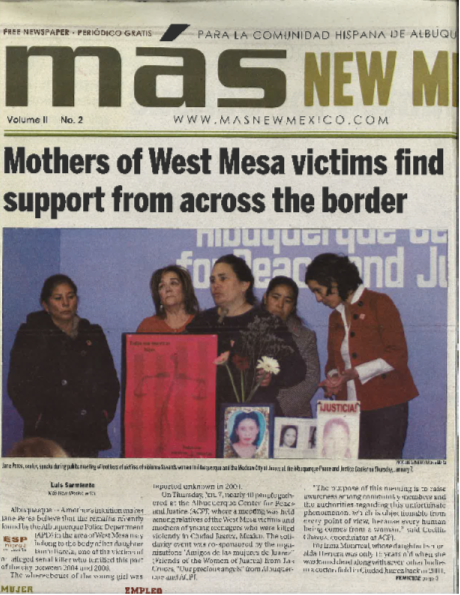
Figure 9: Irma Monreal and Paula Flores behind Jane Perea, mother of Jamie Barela. The event was organized by the Albuquerque Peace and Justice Center and Amigos de las Mujeres de Juárez (Más New Mexico newspaper).
Maternal Feminicide, the Other Story
Activists and the families of feminicide victims remained extremely vulnerable despite: the advances made through the Inter-American Court ruling in the Campo Algodonero case; the countless developments in making feminicides visible worldwide; and their overall work to end violence. The assassination of Marisela Escobedo, the mother of sixteen-year-old feminicide victim, Rubi Marisol Fraye, on December 10, 2010 proved that violence against women has no end. Marisela Escobedo was one of the most vocal and recognized of activist mothers. She was known for walking daily from her home to the state attorney general’s office in Juárez, wearing only her undergarments and a large placard of her daughter that reached down to her knees. When interests in feminicides waned, her brazen strategy caught the attention of the media and kept her daughter’s case in the spotlight. She was courageous in her actions to make her daughter’s case known widely after a Mexican court found Rubi’s boyfriend, Sergio Rafael Barraza, guilty of the murder. The court subsequently acquitted him after an appeal, so Marisela began her own investigation. She tracked Barraza to Zacatecas, Mexico after he was released, determined to bring him to justice by notifying authorities of his whereabouts, despite the cartel protection that he allegedly had.
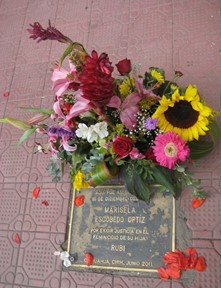
Figure 10: A plaque placed at the site of Marisela’s assassination in front of the Governor’s offices in the historic downtown of Chihuahua City, the state’s capitol. Photo courtesy of author.
Demanding that authorities return her daughter’s murderer to Chihuahua for a retrial, Marisela staged a permanent protest in front of the government offices in Chihuahua City, proclaiming that she would remain there until her daughter’s murderer was arrested. Marisela also shared publicly that she feared for her life, stating that if something were to happen to her, then governor Cesar Duarte would be to blame[13]. It was clear that, “The protection racket called the state [would] no longer protect women activists” (Staudt and Mendez 2009, 15). The government seemed slow to investigate Marisela’s case, even though surveillance footage from the governor’s office caught her assassination on camera. Marisela’s murder emboldened activists because it made everyone both fearful and determined to continue their activist work.
Like so many others, Marisela’s loved ones were forced to flee Juárez. Days after Marisela was killed in Chihuahua City, her brother-in-law was murdered in Juárez and his lumber business was burned to the ground; some reports claim extortionists did this pointing to the confluence of the feminicides and overall criminal activity plaguing Chihuahua. Figures 11 and 12 are of her son, Juan Manuel Frayre Escobedo, protesting with others in front of the Mexican Consulate’s office in El Paso, Texas in 2011. He too received death threats, even in the U.S., but remains vocal about the crimes in Juárez and the corruption and cover-up they experienced with his sister and mother’s deaths. Like his mother, he directly attributed his mother’s death to the then Governor. In the images below, he is holding posters of his murdered younger sister, Rubi, and his mother, with the words ‘Crime of the State’ in bold print under Marisela’s photograph.
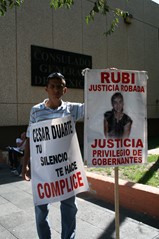
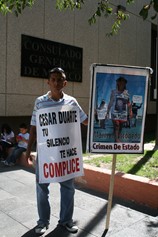
Figure 10 and 11: Juan Manuel Frayre Escobedo holding posters of Rubi and Marisela in front of the Mexican Consulate’s Office in El Paso, Texas. Photo courtesy of author.
Marisela’s death, like that of anti-feminicide/anti-militarization activist, Josefina Reyes, who was killed in 2010 in Juárez when she protested the presence of the military and her son’s disappearance, are forever entrenched in our memories. Several members of Josefina’s family were killed in 2010 and 2011, while other family members fled to the U.S. Norma Andrade, mother of Lilia Alejandra mentioned earlier, was shot and wounded on December 2, 2011. After her recovery, she fled to Mexico City and remains vocally active from there. During these murderous years, nothing felt sacred. The targeting of mothers that searched for their missing children shook people to their core. Marisela and Josefina are revered as folk heroines, demonstrating tremendous bravery in the face of terror that cost them their life.
The Humanity of Juárez, the Real Story of Survival
In Juárez, courage trumps violence. Juárenses are some of the bravest and most resilient people I know. The will of Juárenses to survive such carnage personifies the strength of its people and communities, and the legacy that the anti-feminicide movement has had in sustaining its momentum. Juárez is as dynamic and complicated as it is vibrant and fearless. A generation of young people have learned of feminicide as part of their collective history, and despite the fears and dangers that they experience or circumvent, they become active in events like the 2009 Marcha del coraje, dolor y desagravio, where young people were lying on the streets of Juárez representing those killed during the ‘Great Violence’ (Claudia Cervantes-Soon 2017). Others have created protest art through murals, like the work of graffiti artist, Maclovio Macias and his partner and fellow activist, Lluvia Rocha who have painted more than twenty murals with twenty-five portraits of the disappeared or confirmed feminicide victims in Juárez (Figure 13) (Villagran 2017).
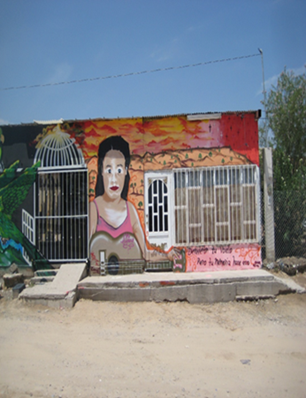
Figure 13: Juárez artist, Maclovio Macias, began painting murals of feminicide victims across the city. This mural is of Sagrario Flores that Maclovio painted on the façade of Paula Flores’ home. Photo courtesy of author.
Other equally significant activities are exemplified through the work of Claudia Cervantes-Soon whose research explores Juárez girls’ empowerment using autogestión, a “holistic and dialectical approach to humanization and a unique form of agency and self-authorship in which young Juárez women engaged individually and collectively . . . in shaping their identity, agency, and transformative educational practices in Juárez” (2017, 5). Some young women are using social media and a new phone app called No Estoy Sola (I am not alone) created by the city government to notify loved ones if they are in danger by shaking their phones and sending a signal of their location to select contacts (Flores 2017). It is vital to underscore the counternarratives of resistance that undergird much of Juárensen society. Juárenses demonstrate that surviving ongoing feminicides and other abominations is possible, as is living to honor those forcefully disappeared that we mourn.
Activist mothers, like Paula Flores and Eva Arce, continue to dedicate their lives to memorializing their daughters. Eva continues to search for her daughter. They remain involved in the anti-feminicide movement, even after twenty years. Eva continues to write poetry to Sylvia, her daughter, and Paula continues to energize the Fundacion Maria Sagrario when time and funding are possible, along with maintaining her daughter’s love of children through the Jardin de Ninos Maria Sagrario, a kindergarten in Sagrario’s honor where Sagrario’s young sister works as a teacher. Figure 14 is a photograph of one of several Christmas posadas (shelter)[14] that Paula and her family hosted for her community. The food they made and the toys that were collected for hundreds of children from 2004 to 2009 illustrate the resiliency in Juárez that is visible everywhere, despite the ongoing violence. These posadas celebrate Sagrario’s life and, as Paula explains, because of this “Sagrario’s memory lives on.”
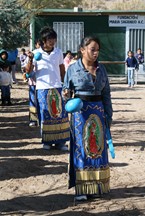
Figure 14: Neighborhood children dancing to the Virgen de Guadalupe during a December 2009 posada at Paula Flores’ house. The Fundación Maria Sagrario can be seen in the background. Photo courtesy of author.
Decolonizing Work Across Borders
The “Missing Women: Decolonization, Third Wave Feminism, and Indigenous People of Canada and Mexico” conference in 2008 exposed what setter-colonialism does to Indigenous/Aboriginal and subaltern communities of color. An unforgettable memory from this conference is of watching Paula and Eva meet Indigenous/Aboriginal mothers during the opening prayer given by First Nations Elders from the original territories now known as Saskatchewan. I kept asking myself, how is it possible to have so many women killed and disappeared near this borderland, like those from our own borderlands? I cried quietly to one side as community members enveloped Paula and Eva with warmth, kindness, and solidarity. I watched with reverence as First Nations Elders blessed the opening ceremony and men drummed and sang; later in the conference proceedings, a group of Indigenous women would drum and invite Paula and Eva to join them. Albeit different but familiar, I recalled the drumming of teenage boys at Paula’s house in Juárez, also drumming to the sacred, and the memory of a feminicide victim.
As strangers for only a short while, mothers from two countries embraced each other after sharing their daughters’ stories of disappearance. It was a surreal experience to see a virtual mirror image of the anti-feminicide movement in Mexico as it simultaneously unfolded in Canada. Blatant indications of the racism, sexism, classism, and colonialism plaguing Indigenous/Aboriginal and Mexican women are too familiar, too normalized, and too often eschewed. We are bound to each other in this life beyond walls, borders, and cultures, as the mothers demonstrated during their time together.
We know that women do not just disappear into thin air, so we name out loud, as Kimberlé Crenshaw (1991)[15] encourages us to do, the greater structural factors at work that create the social, political, and economic conditions that contribute to feminicide. As Canadian scholar, Amber Dean states, “disappearances have been brought about by numerous complex social forces” (2015, 29). How do we account for our sisters, our neighbors, or people we do not know personally but must care for? Dean’s poignant question asking, “What might it mean to inherit what lives on from the disappearance of so many women, and why should a wider public engage in such practices, even—or perhaps especially—when we did not know the women in life? Simon asserts that “the work of inheritance is an inescapable consequence of the actions of another who has sent you something . . . that implicates you in the necessity of a response (even if that response is ultimately to ignore or destroy the bequest)” (2006, 194 as cited in Dean 2016, 7).
When I was given the privilege of attending this Missing Women’s conference with Paula Flores and Eva Arce, I inherited a responsibility to teach about the forcefully disappeared Indigenous women of Canada as often as I could in the same manner that I teach about the disappeared women of Mexico. It is an axiomatic response to act as a witness-observer who represents “a synergy between seeing, hearing, feeling, and reacting to violence as a secondary witness to an atrocity. Secondary witnessing entails a community pledge to tell the stories, in writing or orally, of our own observations and recollections. Just as important, we disseminate the testimonios of human rights activists and of victims, whose truths are overlooked, dismissed, or silenced. Witness observers commit to bearing witness and demanding justice to right the transgressions done to others” (Bejarano, 196).
My use of terms like witness-observers and feminicide, are acts of witness-observing and using activist, pedagogical, and epistemological approaches to work to end feminicides. Our inheritance of this violence translates to bridging our countries’ borders for solidarity work in efforts to end disappearance and feminicide—subaltern, Indigenous, Aboriginal, Mexican, or otherwise.
I would like to thank Diana Lopez and Zaira Martin for their assistance with this article, and the efforts of so many in Juárez to return the city to its vibrant self, especially those individuals in the anti-feminicide movement.
(All images are copyright protected and are the property of the author. No copying or usage is permitted for purposes other than within the context of this chapter.)
Bejarano, Cynthia. 2013. “Memory of Struggle in Juárez: Las Madres’ Organic Resistance, Transborder Activism and the Campo Algodonero.” Aztlan: Journal of Chicana/o Studies, 38 (1): 189-204.
Bejarano, Cynthia and Morales, Maria Cristina. 2011. “Analyzing Conquest through a Border Lens: Vulnerable Communities at the Mexico–U.S. and Moroccan–Spanish Border Regions.” In El Río Bravo Mediterráneo: Las regiones fronterizas en la época de la globalización, edited by Natalia Ribas-Mateos, (117-129). Ediciones Bellaterra: Barcelona, Spain.
Borunda, Daniel. 2017. “Journalist killed at her Chihuahua City home.” El Paso Times March 23. Retrieved June 26, 2017, from http://www.elpasotimes.com/story/news/crime/2017/03/23/journalist-killed-her-chihuahua-city-home/99546836
Candia, Adriana, Cabrera, Patricia, Martínez, Josefina, Velázquez, Isabel, Benítez, Rohry, De La Mora, Guadalupe, and Ramona Ortiz, 1999. El Silencio que la voz de todas Quiebra: Mujeres y víctimas de Ciudad Juárez. Chihuahua: AZAR.
Carmona, Blanca. 2017. Confirman sentencia por caso de arroyo El Navajo. El Diario.
March 7. Retrieved July 31, 2017, from http://diario.mx/Local/2017-03-06_81b56e2f/confirman-sentencia-por-caso-de-arroyo-el-navajo/
Cave Damien. 2013. “Ciudad Juárez, a Border City Known for Killing, Gets Back to Living.” The New York Times, Dec 14. Retrieved July 31, 2017 from, https://www.nytimes.com/2013/12/15/world/americas/a-border-city-known-for-killing-gets-back-to-living.html
Cervantes-Soon, Claudia. G. 2017. Juárez Girls Rising: Transformative Education in Times of Dystopia. Minneapolis, MN: University of Minnesota Press.
Crenshaw, Kimberlé. 1991. Mapping the Margins: Intersectionality, Identity Politics and Violence Against Women of Color. Stanford Law Review, vol. 43, no. 6 (1241-1299).
Dean, Amber. 2015. Remembering Vancouver’s Disappeared Women: Settler Colonialism and the Difficulty of Inheritance. Toronto: University of Toronto Press.
Driver, Alice. 2015. More or Less Dead: Feminicide, Haunting, and the Ethics of Representation in Mexico. Tuscon, AZ: The University of Arizona Press.
Estrada, Ismael, Keck, Kristi, Rodriguez, Rey, and Barbara. Starr. 2009. “Violence Spillover from Mexico is Focus of House Hearing.” CNN politics, March 12. Retrieved July 31, 2017 from, http://www.cnn.com/2009/POLITICS/03/12/border.hearing/index.html
Flores, Aileen B. 2017. “New app can help Juárez women who are in danger. El Paso Times, July 7. Retrieved August 5, 2017 from, https://www.elpasotimes.com/story/news/local/community/2017/07/07/new-app-can-help-Juárez-women-who-danger/457857001/
Frontera Norte Sur. 2015. “Juarez Judges Throw Away the Key on Femicide Case Defendants.” Fnsnews July 28. Retrieved September 25, 2019 from, https://fnsnews.nmsu.edu/juarez-judges-throw-away-the-key-on-femicide-case-defendants/
Fregoso, Rosa Linda, and Cynthia Bejarano (Eds.). 2010. Terrorizing Women: Feminicide in the Americas. Durham, NC: Duke University Press.
Lagarde y de los Ríos, Marcela. 1996. Género y feminismo. Desarrollo humano y democracia. Madrid: Horas y Horas.
Lozano, Nina Maria. 2019. Not One More!: Feminicidio on the Border. Columbus: The Ohio State University Press.
Mesa de Seguridad y Justicia. 2017. Sistematización y Guía del modelo de Mesas de Seguridad y Justicia. Serie relación gobierno-sociedad. Retrieved August 15, 2017. http://mesadeseguridadchihuahua.org/
Monárrez Fragoso, Julia. 2000. “La cultura del feminicidio en Ciudad Juárez. 1993-1999.” Revista Frontera Norte, Colegio de la Frontera Norte. vol. 12, no.23:87-111.
Ortiz, Alexis. 2019. El Universal. Former Mexican Governor Allegedly Hiding in New Mexico. July 15. Retrieved September 27, 2019 from, https://www.eluniversal.com.mx/english/former-mexican-governor-allegedly-hiding-new-mexico
O’Rourke Beto, Byrd Susie. 2011. Dealing Death and Drugs: The Big Business of Dope in the U.S. and Mexico. El Paso: Cinco Puntos Press.
Radford, Jill, and Diana E.H Russell (eds.). 1992. Feminicide: The Politics of Woman Killing. New York: Twayne.
Sarmiento, Luis. 2010. “Mothers of West Mesa victims find support from across the border.” January 13. MAS New Mexico. Retrieved September 27, 2019, from http://www.masnewmexico.com/mas/archivo/2010/enero/masnmpub011310.pdf
Villagran, Lauren. 2017. “Faces of Femicide: Artist, blogger memorialize victis of Juárez.” March 12. Albuquerque Journal. Retrieved August 3, 2017, from https://www.abqjournal.com/967253/femicide-victims-memorialized.html
Washington Valdez, Diana. 2006. Harvest of Women: Safari in Mexico (1993-2005). Los Angeles: Peace at the Border.
- I will use Juárez instead of Ciudad Juárez throughout this writing. ↵
- The term femicide, which means “the act of killing women because they are women” (Radford and Russell 1992), is extensively used across the Americas and builds on the work of U.S. based sociologists, Jill Radford and Diana E. Russell, and Mexican cultural anthropologist and former Mexican congresswoman, Marcela Lagarde y de los Rios (1996), as well as the work of Juárez based sociologist, Julia Fragoso Monárrez (1999). For a historical account of the terms femicide and feminicide, see Marcela Lagarde y de los Rios’ explanation of how femicide and feminicide are discussed in the anthology, Terrorizing Women: Feminicide in the Americas (Fregoso and Bejarano 2010). After working as on the ground activists and scholars for over twenty years, my colleague Rosa-Linda Fregoso and I have built our definition of feminicide from the works of the aforementioned, influential feminists to further conceptualize the concept. We describe feminicide as, “first, the murders of women and girls founded on a gender power structure and with impunity; second, feminicide is gender-based violence that is both/and public and private, implicating both the state (directly or indirectly) and individual perpetrators (private or state actors); it thus encompasses systematic, widespread and every day, random violence; third, feminicide is systemic violence, rooted in social, political, economic, and cultural inequalities . . . our analysis is not just on gender, but also on the intersection of gender dynamics with the cruelties of racism and economic injustices in local as well as global contexts; finally, our framing of feminicide as violence that reinforces a systematic pattern of subordination also advances a critical human rights perspective for countering the murders and disappearances of women, with the language of justice and empowering communities to act on behalf of social change” (Fregoso and Bejarano 2010, 5). Our comprehensive feminicide framework has the potential for wide applicability in most regions across the globe where women are targeted, and where communities stand in defiance of this violence. ↵
- Narco translates loosely as drug smuggler/drug trafficker, and narco deaths are popularly defined as deaths associated with the drug trade. However, innocent people have also been killed in the crossfire of drug traffickers with rival cartels or with authorities. ↵
- The violence in Juárez is personal for me. I have lived at the U.S.-Mexico borderlands in New Mexico and Arizona my entire life. I grew up in Southern New Mexico, just miles away from Juárez and was raised crossing the border back and forth for dental care, shopping, visiting friends, and now to visit close activist friends that I consider family. I am of Mexican descent; generations ago, my great-grandparents and their parents came from various cities across the state of Chihuahua to settle in New Mexico. My love and admiration for the people of Juárez stems from my involvement with the advocacy group Amigos de las Mujeres de Juárez that worked with several women’s and human rights groups across the state of Chihuahua and the U.S. to address the feminicides in Northern Chihuahua. ↵
- In extreme cases, Juárenses fled Juárez and the border area altogether, seeking refuge within the interior of Mexico or beyond. ↵
- This was an emotional event for me because I wanted to be in Juárez, but I stayed in El Paso during an especially tumultuous set of weeks across the border. ↵
- Paula Flores is the mother of Sagrario Gonzalez killed in 1998. Sagrario’s death served as an impetus for my involvement in the anti-feminicide movement in 1998. Paula was at the University of Regina’s conference on Missing and Indigenous Women with Eva Arce, mother of Sylvia Arce who went missing in 1998, and whose status remains as a missing person. I met both women in 1998. In 2001, our New Mexico based group, Amigos de las Mujeres de Juarez, worked closely with Paula and Eva. ↵
- These locations are on the outskirts of Juárez except for the cotton field, Campo Algodonero. ↵
- Rastreos are areas where people carefully search for any trace of evidence for the bodies of missing women and girls. This practice has been ongoing for nearly twenty years and is now a common occurrence. During the ‘Great Violence,’ men and boys were also searched for. ↵
- This list stems from data gathered by a Chihuahua City group Justicia Para Nuestras Hijas, which is comprised of mothers of feminicide victims. The list stems from a 2015 presentation given by Laura Aragon, founder of Mukira, a non-profit that works with women and youth in Mexico toward gender equality, transforming Mexico’s culture of legality, violence prevention, human rights, access to justice, and youth leadership and empowerment. The list is not an exhaustive one, nor is it meant to omit other individuals whose remains were found or still missing. It is a list to remember that these people existed, they lived before they were forcefully disappeared and exploited. ↵
- Comunitarios observatorios are comprised of civic-society groups like women’s rights and human rights organizations, legal defense groups, religious and Indigenous women’s groups, and others that work as a monitoring body on issues of feminicide. The largest observatory in Mexico on feminicide is the Observatorio Ciudadano del Feminicidio (Fregoso and Bejarano 2010, 26). Observatories are practiced widely in Latin America. ↵
- Esmeralda Herrera was a 14-year-old girl whose body was found in the irrigation canal of a cotton field in 2001. Irma was one of the three lead petitioners in the Campo Algodonero case. ↵
- Cesar Duarte was notoriously corrupt during his tenure as governor of Chihuahua. In 2017, Interpol released a report with a red notice against Duarte, making him a wanted individual in 190 countries. The state of Chihuahua has issued 10 arrest warrants against him, and he is accused of illicit enrichment and aggravated embezzlement. He is said to be in hiding in Albuquerque, New Mexico (Ortiz 2019, 2). ↵
- A posada is a religious celebration that is popular throughout Latin America and that marks the pilgrimage of Mary and Joseph seeking refuge for baby Jesus. The posada is traditionally practiced by community members praying the rosary while walking from house to house, hence, reenacting the imagery of Mary and Joseph seeking shelter. Paula celebrates posadas at her home with matachine dancers, children and community members from her neighborhood that venerate the Virgen of Guadalupe, the patron saint of Mexico, with Indigenous drumming and dancing to the image of the Guadalupe. The Virgen of Guadalupe’s Catholic saint’s day is December 12. Paula holds this event each year to venerate the Virgen of Guadalupe and to honour Sagrario’s memory. ↵
- In the U.S., Kimberlé Crenshaw coined the term intersectionality, which offers a framework to analyze, “the various ways in which race and gender intersect in shaping structural, political, and representational aspects of violence against women of color” (Crenshaw 1991, 1244). ↵

